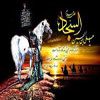
Imam Sadjad (A.S) delivered another sermon in the precincts of Medina for the people who had come to see the sorrowful caravan of captives. This sermon, too, deeply affected people so that a year after Ashura tragedy people of Medina revolted against Bani Umayyah. Their revolution is known as Harrah Uprising.
Purposeful and Saddening Tears
Imam Sadjad (A.S) used to shed tears on every occasion to commemorate the martyrs of Karbala. Today, all the lamentations that have formed the culture of Karbala come from his incessant efforts. When they asked the Imam about his crying he said: "Woe on to you! Prophet Jacob (PBUH) had twelve sons; however, when Allah took away one of them, grief overtook him so much that his hair was whitened, his back was bent, and he lost his vision due to excessive crying, even though his son was actually alive. But I witnessed with my own eyes how my father, my brother, and seventeen of my family members were killed. So how do you expect my sadness to be relieved or my lamentation to be over?"[i]
Supporting Anti-Oppressor Uprisings
One of the major impacts of Ashura Uprising was creating the spirit of epic and courage among the Muslims. The free people of the world took aspirations from the Ashura Uprising and the revelations of Imam Sadjad (A.S) and Hazrat Zeinab to rise against the despotic rulers. Three distinguished uprisings were Tavvabin, Mokhtar Saqafi, and Medina.
source : www.tebyan.net













